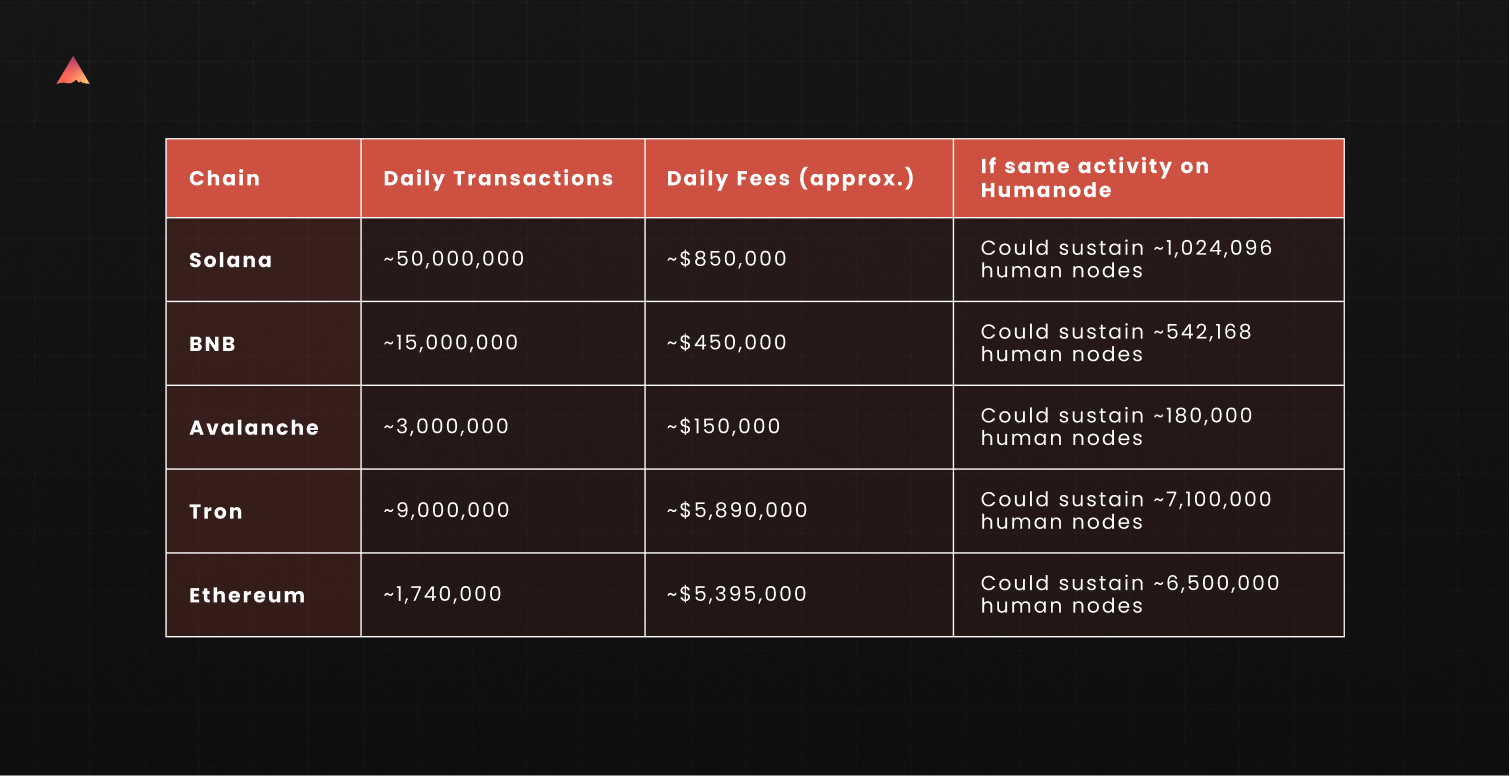What activity on Humanode really means

In our last article, we talked about what fees mean for the people securing Humanode. This time, we look at the bigger picture: how activity itself becomes the pulse that drives validator growth, token emission, and the network’s economic life.
When people talk about fees, they usually mean cost. On Humanode, they mean decentralization. Here’s what happens when activity becomes the measure of decentralization itself.
Every chain needs movement. Without it, nothing matters. No clever code, no whitepaper, no promise of revolution. Just silence. Activity is what keeps a chain alive. Fees come after. They’re proof that something moved, that someone somewhere did something. But they’re not the heartbeat. The movement is.
When you look at the big ones like Ethereum, Solana, BNB Chain, Avalanche, you can feel that movement. Millions of transactions every day. Real users doing things. But if you follow where that activity leads, the trail always ends up in the same few places. The biggest stakers. The biggest machines. The same operators who already owned the map.
It’s strange, isn’t it? The more people use the network, the more it belongs to fewer people. The pie grows, but the table stays small.
That isn’t decentralization. It’s a kind of order that hides behind the word.
The dream was never to build perfect machines that reward whoever started rich. It was to build something that keeps running because people use it, and anyone can take part.
Now imagine if that same flood of activity happened on Humanode. The same trades, mints, games, votes, all of it. The difference isn’t in scale, it’s in where the value goes when people move. Here, the reward loops back to the humans who keep the network alive.
Each transaction becomes support for someone running a node. Each bit of activity makes decentralization more real. The busier the chain gets, the more humans it can sustain. The more humans it sustains, the more decentralized it becomes.
What would that look like if all that energy we see on other chains passed through Humanode? The same volume, the same noise, but every click and every trade helping someone somewhere stay part of the system.
That’s the question worth exploring.
If the same activity happened here
Let’s look at what that kind of activity really means in numbers.

Solana processes tens of millions of transactions daily, generating hundreds of thousands of dollars in fees. BNB and Avalanche follow close behind. On those networks, most of that value cycles back to large validators and staking pools, scaling returns for those who already run the biggest operations.
On Humanode, it would do something else entirely.
Validator rewards don’t inflate here. They stay stable, designed to cover what each human node needs to operate sustainably. The difference is that when activity grows, the system can support more human nodes at that same equilibrium level.
More activity means more humans can join. More humans mean more decentralization. That’s the feedback loop.
If the Humanode network processed Solana-level activity, the total fees would be enough to sustain around one million verified human nodes. That’s not wealth redistribution. That’s network expansion through real participation and true decentralization.
And those same people will all have a voice in Vortex, Humanode’s governance. Each one with one vote, equal in weight. No matter how many whales join, their influence stays the same as that of a shrimp holding 1 HMND.
And that same activity wouldn’t just sustain validators. It would drive Fath, the system that governs Humanode’s monetary issuance.
Fath doesn’t print or burn tokens based on politics or speculation. It watches what the network actually does. It measures real throughput, which we call the Gross Network Product(GNetP), and adjusts supply in direct proportion.
When activity and transaction volume rise, Fath mints new supply (inFath). When activity falls, it burns (outFath). It’s a living system that expands and contracts with real economic motion, not arbitrary emissions.
In the early phase, GNetP is based on transaction fees. Later, it grows to include Designated Accounts, meaning accounts tied to real productive activity, dApps, services, marketplaces, or tools built on the chain. Over time, Fath becomes a mirror of real network utility.
So the more activity Humanode has, the more validators it can sustain, and the more precisely Fath can adjust the supply to reflect real value creation.
That’s the difference. In other networks, activity enriches a few. In Humanode, activity feeds people, supports validators, and aligns issuance with what’s actually happening on-chain.
What would that kind of activity mean?
If that level of activity ever moved through Humanode, it wouldn’t just change numbers on a dashboard. It would change the shape of the network itself. Because on Humanode, activity doesn’t climb upward. It spreads. Every new transaction, every project, every small bit of motion sends value sideways, to the humans keeping it alive.
A developer in Turkey building a dApp.
A validator in Brazil keeping uptime steady.
A player in the Philippines trading in-game assets.
All part of the same pulse. All part of the same living system made of humans, not hardware.
The more people use the network, the more humans it can afford to bring online. The more humans join, the safer and more resilient it becomes. That’s decentralization feeding itself.
So when we talk about growth, we’re not really talking about money. We’re talking about motion. The kind that crosses borders naturally, that doesn’t need permission or capital to start.
That’s what activity means here. It’s not just fuel. It’s proof that the system works as intended, alive, expanding, and self-balancing.
Rethinking what decentralization means
People say decentralization so often that it’s almost lost meaning. It’s on banners, websites, whitepapers, everywhere. But when you look closer, most networks still run the same way. A few powerful operators keep things moving, and the rest of us just use the system.
The idea behind decentralization was simple: no one should own the network. No one should be able to shut it down. It should belong to everyone who takes part. But somewhere along the way, that became a numbers game. More nodes, more TPS, more TVL. As if growth alone proved fairness.
When you check who actually runs those networks, it’s usually a few hundred entities. That’s it. The rest of us fund them through fees. It’s efficient, but it’s not what decentralization was supposed to be.
Humanode changes that equation. A validator here isn’t a stake or a machine. It’s a person. Someone who proved they exist and chose to help secure the chain. The more people there are, the more spread out power becomes.
If the kind of activity we see on big chains ever landed here, it wouldn’t just mean higher numbers. It would be proof that decentralization can grow with use instead of shrinking under it. That scale doesn’t have to mean hierarchy. That a network can expand while keeping power where it started, with the people.
It’s not about perfection. It’s about staying human as it grows. A network that doesn’t lose its purpose just because it gets big.
That’s what decentralization was supposed to mean before the word got overused. Maybe that belief isn’t lost. Maybe it just needed a system built to remember what it was supposed to be.
The network grows with us
In the end, it all comes back to activity. That’s what keeps the network alive. People using it. Moving things around. Building. Trying things.
Most blockchains take that movement and feed it back to capital. Humanode feeds it back to people. That’s the difference.
Every transaction here supports someone running a node. It keeps another human part of the system. It turns motion into something that holds the network together.
We don’t need to chase the biggest chains. What matters is that people keep showing up. Every time they do, the network gets a little stronger. A little more human.
More projects will come. More games, apps, tools, and experiments. More reasons for people to use the chain. And as that happens, more humans will join as validators. Not because they bought their way in, but because they belong here by being real.
That’s what decentralization really means. Not perfection. Just people keeping something alive together.
Maybe that’s all it takes. A network that grows because people use it. A system that stays fair because everyone has a piece of it. Simple, but it works.
So, in short, activity = life of the network. If you have an idea that could strengthen this motto: a dapp, a tool, your research, or any design, bring it forward. You can propose it in the proto-vortex and get Humanode support to build it.
Learn how to join proto-vortex.
Full guidelines: https://blog.humanode.io/invitation-to-the-proto-vortex/
Submit proposals: https://link.huamnode.io/proto-vortex/rules

